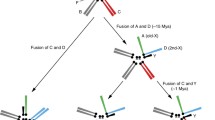Abstract
Mutations in the Third chromosome resistance (Tcr; 3-39.6) gene confer dominant resistance to α-methyl dopa and suggest the gene is involved in catecholamine metabolism. Evidence for involvement in catecholamine metabolism comes from the three phenotypes associated with the mutant Tcr chromosomes dominant resistance, dominant rescue of partially complementing l(2)amd alleles, and recessive lethal phenotypes. Only dominant resistance to αs-methyl dopa, however, was mapped to the Tcr locus. Both recessive lethality and dominant rescue of l(2)amd alleles have now been mapped to the Tcr gene and, through the isolation of a new deletion in the region, we demonstrate these phenotypes are due to a loss of Tcr function. This deletion places the Tcr gene in the 69B4-5 to 69C8-11 region. Additionally, we have tested and verified three predictions of the biochemical model proposed by Bishop, Sherald, and Wright (1989) for the function of the Tcr protein.
Similar content being viewed by others
References
Akam, M.E., D.B. Roberts, G.P. Richards & M. Ashburner, 1978. The genetics of two major larval proteins. Cell 13: 215–226.
Bishop, C.P., A.F. Sherald & T.R.F. Wright, 1989. Characterization of the third chromosome dominant α-methyl dopa resistant mutants (Tcr) and their interactions with l(2)amd α-methyl dopa hypersensitive alleles in Drosophila melanogaster. Genet. Res. Camb. 54: 93–99.
Bishop, C.P. & T.R.F. Wright, 1987. Ddc DE1, a mutation differentially affecting both the stage and tissue specific expression of dopa decarboxylase in Drosophila. Genetics 115: 477–491.
Black, B.C., E.S. Pentz & T.R.F. Wright, 1987. The alpha methyl dopa hypersensitive gene, l(2)amd, and two adjacent genes in Drosophila melanogaster: Physical localization and direct effects of amd on catecholamine metabolism. Mol. Gen. Genet. 209: 306–312.
Eveleth, D.D. & J.L. Marsh, 1986. Evidence for evolutionary duplication of genes in the dopa decarboxylase region of Drosophila. Genetics 114: 469–483.
Giorgi, G., M.C. Pezzoli, S. Cavicchi & D. Guerra, 1995. Approximated: A gene involved in the control of cell proliferation. Europ. Dros. Res. Conf. 14: 303a.
Hopkins, T.L. & K.J. Kramer, 1992. Insect cuticle sclerotization. Annu. Rev. Entomol. 37: 273–302.
Lindsley, D.L. & E.H. Grell, 1968. Genetic Variations of Drosophila melanogaster. Carnegie Inst. Wash. Publ. p. 627.
Lindsley, D.L. & G.G. Zimm, 1992. The Genome of Drosophila melanogaster. Academic Press, San Diego, CA.
Marsh, J.L., M.P. Erfle & C.A. Leeds, 1986. Molecular localization, developmental expression, and nucleotide sequence of the alphamethyl dopa hypersensitive gene of Drosophila. Genetics 114: 453–467.
Marsh, J.L. & T.R.F. Wright, 1986. Evidence for regulatory variants of the dopa decarboxylase loci in Drosophila. Genetics 112: 249–265.
Olney, J.W., C.F. Zorumski, G.R. Stewart, M.T. Price, G. Wang & J. Labruyere, 1990. Excitotoxicity of L-DOPA and 6-OHDOPA: Implications for Parkinson's and Huntington's diseases. Exp. Neuro. 108: 269–272.
Sparrow, J.C. & T.R.F. Wright, 1974. The selection for mutants in Drosophila melanogaster hypersensitive to α-methyl dopa, a dopa decarboxylase inhibitor. Mol. Gen. Genet. 130: 127–141.
Sun, Y.H., C.J. Tsai, M.M. Green, J.L. Chao, C.T. Yu, T.J. Jaw, J.Y. Yeh & Y.N. Bolshakov, 1995. White as a reporter gene to detect transcriptional silencers specifying position-specific gene expression during Drosophila melanogaster development. Genetics 141: 1075–1086.
Turnbull, I.F., N.A. Pyliotis & A.J. Howells, 1980. The effects of dopa decarboxylase inhibitors on the permeability and ultrastructure of the larval cuticle of the Australian sheep blowfly, Lucilia cuprina. J. Insect Physiol. 26: 525–532.
Wright, T.R.F., 1987. The genetics of biogenic amine metabolism, sclerotization, and melanization in Drosophila melanogaster. Adv. Gen. 24: 127–223.
Wright, T.R.F., B.C. Black, C.P. Bishop, J.L. Marsh, E.S. Pentz, R. Steward & E.Y. Wright, 1982. The genetics of dopa decarboxylase in Drosophila melanogaster. Mol. Gen. Genet. 188: 18–26.
Author information
Authors and Affiliations
Rights and permissions
About this article
Cite this article
Bishop, C.P., Talomie, T.G. & Lewis, W.D. Cytological location and further characterization of the Third chromosome resistance gene in Drosophila melanogaster. Genetica 105, 117–124 (1999). https://doi.org/10.1023/A:1003650711793
Issue Date:
DOI: https://doi.org/10.1023/A:1003650711793




